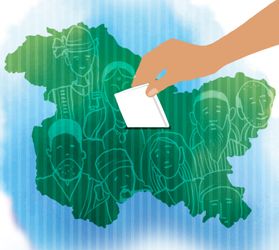Seerat Naaz, an eight-year-old Jammu girl, pleaded with the prime minister to get her 87-year-old school rebuilt. “Please Modiji, humarey liye ek acha sa school banwa do na,” she said in a video, that went viral, showing her school’s dirty floors and broken doors. Narendra Modi listened, and acted; the school is being repaired.
That is the sign of a responsive government—one that responds to the needs of the aam admi, aam aurat, aam ladka or aam ladki. Not only Modi, but many of his colleagues have been leading their ministries by similar examples, originally set by the dear departed Sushma Swaraj. As Modi’s first foreign and overseas affairs minister, she used to look into every tweeted message of grievance, and address it.
There are credible stories galore in the mainstream media, and more incredible stories in the social media, of how cabinet ministers have helped people get train tickets confirmed, pensions released, phone lines restored, ambulances despatched, exams ordered, complaints attended, refugees rescued, and even damsels saved from distress—not just from within India, but even from conflict zones on distant shores such as Sudan and Syria. All on receipt of a simple tweet or a WhatsApp post.
But you can’t expect your ministers to be Harun-al Rashids going out in disguise every night to catch thieves, rescue damsels, feed the poor, and find out if all’s well in the kingdom. Moreover, such Zorro-like acts can redress only individual grievances, adding to a corpus of anecdotal governance. What about the collective grievances of the people at large, redress of which involves policy decisions, administrative rethink, or legislative action?
To address collective concerns, you need not only responsive governments but also responsible governments. Most of us who inhabit the landmass that stretches from Kashmir to Kanyakumari have such governments in our states. When any of those governments turn irresponsible, we vote it out—as the Kannadigas have just done.
Hold on. Didn’t we make two wrong assumptions? One, India no longer stretches from Kashmir to Kanyakumari; it stretches from Ladakh to Kanyakumari now. Two, Seerat Naaz’s folk, who live in Jammu and Kashmir that has been split from Ladakh into another Union territory, don’t have a responsible government yet.
Through a smart administrative coup, Modi and Amit Shah burst the bubble of special status that Jammu and Kashmir had been enjoying, and bifurcated its territory into two UTs—Jammu & Kashmir and Ladakh. The rest of the world fretted, China fumed and Pakistan fulminated, but all the sound and fury signified nothing in the end. At the same time, to assuage the feelings of the people, the government also promised restoration of statehood, and holding of assembly elections.
It has been four years now. The government claims that the valley, once a hotbed of insurgents, is back to near-normal save for stray encounters. Buses are running, people are going to work, kids are going to schools, farmers are going to orchards, tourists are coming, investors are trickling in. No stones are being pelted, no grenades lobbed, and hartal calls are hardly heard.
Pray, what is delaying the polls? Constituencies have been delimited, electoral rolls readied, and politicians are ready—even those who had been threatening to boycott polls. Even panchayat and municipal polls are going to be held in the next few months. Why not to the legislative assembly?
Having an elected government in the valley of strife will only enhance the prestige of India in this G20 year.
prasannan@theweek.in


